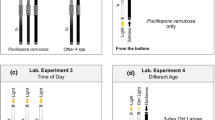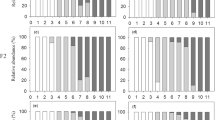Abstract
The marine copepod Calanopia americana Dahl undergoes twilight diel vertical migration (DVM) in the Newport River estuary, North Carolina, USA, in synchrony with the light:dark cycle. Copepods ascend to the surface at sunset, descend to the bottom around midnight, and make a second ascent and descent before sunrise. Behavioral assays with C. americana in the laboratory during fall 2002/2003 and summer 2004 investigated aspects of three hypotheses for the proximate role of light in DVM: (1) preferendum hypothesis (absolute irradiance), (2) rate of change hypothesis (relative rates of irradiance change), and (3) endogenous rhythm hypothesis. Results suggest that C. americana responds to exogenous light cues consistent with its DVM pattern; changes in absolute irradiance evoked swimming responses that would result in an ascent at sunset and descent at sunrise, while relative rates of irradiance decrease at sunset (−0.0046 s−1) evoked an ascent response, and relative rates of irradiance increase at sunrise (0.0042 s−1) evoked a descent response. Furthermore, C. americana expressed an endogenous rhythm in vertical migration that was positively correlated with field observations of twilight DVM. Collectively, these results indicate that both exogenous light cues and endogenous rhythms play a proximate role in twilight DVM of C. americana, providing redundancy in the causes of its vertical migration.





Similar content being viewed by others
References
Aschoff J (1966) Circadian activity patterns with two peaks. Ecology 47:657–662
Boden BP, Kampa EM (1967) The influence of natural light on the vertical migrations of an animal community in the sea. Symp Zool Soc Lond 19:15–26
Bollens SM, Frost BW (1989a) Zooplanktivorous fish and variable diel vertical migration in the marine planktonic copepod Calanus pacificus. Limnol Oceanogr 34:1072–1083
Bollens SM, Frost BW (1989b) Predator-induced diel vertical migration in a planktonic copepod. J Plankton Res 11:1047–1065
Champalbert G (1978) Rythmes d’activité natatoire de quelques Copépodes hyponeustoniques (Anomalocera patersoni Templeton, Pontella mediterranea Claus, Labidocera wollastoni Lubbock) en fonction des conditions d’éclairement et de pression. J Exp Mar Biol Ecol 35:233–249
Cohen JH (2004) Visual sensitivity and diel vertical migration of the marine copepod Calanopia americana. PhD thesis, Department of Biology, Duke, Durham
Cohen JH, Forward RB Jr (2002) Spectral sensitivity of vertically migrating marine copepods. Biol Bull (Woods Hole) 203:307–314
Cohen JH, Forward RB Jr (2005) Diel vertical migration in the marine copepod Calanopia americana. I. Twilight DVM and its relationship to the diel light cycle. Mar Biol (in press). DOI 10.1007/s00227-005-1569-x
Cronin TW, Forward RB Jr (1980) The effects of starvation on phototaxis and swimming of larvae of the crab Rhithropanopeus harrisii. Biol Bull (Woods Hole) 158:283–294
Dagg MJ (1985) The effects of food limitation on diel migratory behavior in marine zooplankton. Arch Hydrobiol Beih Limnol 21:247–255
Dagg MJ, Frost BW, Newton JA (1997) Vertical migration and feeding behavior of Calanus pacificus females during a phytoplankton bloom in Dabob Bay, U.S. Limnol Oceanogr 42:974–980
Daro MH (1988) Migratory and grazing behavior of copepods and vertical distribution of phytoplankton. Bull Mar Sci 43:710–729
Dunlap JC, Loros JJ, DeCoursey PJ (2004) Chronobiology. Sinauer, Sunderland, Mass., USA
Enright JT, Hamner WM (1967) Vertical diurnal migration and endogenous rhythmicity. Science 157:937–941
Enright JT, Honegger H-W (1977) Diurnal vertical migration: adaptive significance and timing, part 2. Test of a model: details of timing. Limnol Oceanogr 22:873–886
Forward RB Jr (1976) Light and diurnal vertical migration: photobehavior and photophysiology of plankton. In: Smith K (ed) Photochemical and photobiological reviews. Plenum, New York, pp 157–209
Forward RB Jr (1985) Behavioral responses of larvae of the crab Rhithropanopeus harrisii (Brachyura: Xanthidae) during diel vertical migration. Mar Biol 90:9–18
Forward RB Jr (1988) Diel vertical migration: zooplankton photobiology and behavior. Oceanogr Mar Biol Annu Rev 26:361–393
Forward RB Jr, Cronin TW (1980) Tidal rhythms of activity and phototaxis of an estuarine crab larva. Biol Bull (Woods Hole) 158:295–303
Forward RB Jr, Rittschof D (1999) Brine shrimp larval photoresponses involved in diel vertical migration: activation by fish mucus and modified amino sugars. Limnol Oceanogr 44:1904–1916
Forward RB Jr, Rittschof D (2000) Alteration of photoresponses involved in diel vertical migration of a crab larva by fish mucus and degradation products of mucopolysaccharides. J Exp Mar Biol Ecol 245:277–292
Forward RB Jr, Cronin TW, Stearns DE (1984) Control of diel vertical migration: photoresponses of a larval crustacean. Limnol Oceanogr 29:146–154
Frank TM, Widder EA (1997) The correlation of downwelling irradiance and staggered vertical migration patterns of zooplankton in Wilkinson Basin, Gulf of Maine. J Plankton Res 19:1975–1991
Frank TM, Widder EA (2002) Effects of a decrease in downwelling irradiance on the daytime vertical distribution patterns of zooplankton and micronekton. Mar Biol 140:1181–1193
Haney JF (1988) Diel patterns of zooplankton behavior. Bull Mar Sci 43:583–603
Haney JF (1993) Environmental control of diel vertical migration behavior. Arch Hydrobiol Beih Limnol 39:1–17
Harding GC, Vass WP, Hargrave BT, Pearre S Jr (1986) Diel vertical migration and feeding activity of zooplankton in St. Georges Bay, N.S., using net tows and a newly developed passive trap. Can J Fish Aquat Sci 43:952–967
Harris JE (1963) The role of endogenous rhythms in vertical migration. J Mar Biol Assoc UK 43:153–166
Harris RP (1988) Interactions between diel vertical migratory behavior of marine zooplankton and the subsurface chlorophyll maximum. Bull Mar Sci 43:663–674
Levine J, Funes P, Dowse H, Hall J (2002) Signal analysis of behavioral and molecular cycles. BMC Neurosci 3:1–25
Mackas D, Bohrer R (1976) Fluorescence analysis of zooplankton gut contents and an investigation of diel feeding patterns. J Exp Mar Biol Ecol 25:77–85
Mauchline J (1998) The biology of calanoid copepods. Academic, San Diego, Calif., USA
Ohman MD (1990) The demographic benefits of diel vertical migration by zooplankton. Ecol Monogr 60:257–281
Pagano M, Gaudy R, Thibault D, Loçhet F (1993) Vertical migrations and feeding rhythms of mesozooplanktonic organisms in the Rhône River plume area (north-west Mediterranean Sea). Estuar Coast Shelf Sci 37:251–269
Pearre S Jr (1973) Vertical migration and feeding in Sagitta elegans Verrill. Ecology 54:300–314
Pearre S Jr (2003) Eat and run? The hunger/satiation hypothesis in vertical migration: history, evidence and consequences. Biol Rev 78:1–79
Ringelberg J (1964) The positively phototactic reaction of Daphnia magna Strauss: a contribution to the understanding of diel vertical migration. Neth J Sea Res 2:319–406
Ringelberg J (1995a) Is diel vertical migration possible without a rhythmic signal? Comments on a paper by Bollens et al. (1994). J Plankton Res 17:653–655
Ringelberg J (1995b) Changes in light intensity and diel vertical migration: a comparison of marine and freshwater environments. J Mar Biol Assoc UK 75:15–25
Ringelberg J (1999) The photobehavior of Daphnia spp. as a model to explain diel vertical migration in zooplankton. Biol Rev 74:397–423
Ringelberg J, Kasteel JV, Servaas H (1967) The sensitivity of Daphnia magna Strauss to changes in light intensity at various adaptation levels and its implication in diurnal vertical migration. Z Vgl Physiol 56:397–407
Rittschof D, Williams LG, Brown B, Carriker MR (1983) Chemical attraction of newly hatched oyster drills. Biol Bull (Woods Hole) 164:493–505
Rudjakov JA (1970) The possible causes of diel vertical migrations of planktonic animals. Mar Biol 6:98–105
Sameoto DD (1984) Environmental factors influencing diurnal distribution of zooplankton and ichthyoplankton. J Plankton Res 6:767–792
Stearns DE (1983) Control of nocturnal vertical migration in the calanoid copepod Acartia tonsa Dana in the Newport River Estuary, North Carolina. PhD thesis, Department of Zoology, Duke, Durham
Stearns DE (1986) Copepod grazing behavior in simulated natural light and its relation to nocturnal feeding. Mar Ecol Prog Ser 30:65–76
Stearns DE, Forward RB Jr (1984) Copepod photobehavior in a simulated natural light environment and its relation to nocturnal vertical migration. Mar Biol 82:91–100
Sweatt AJ, Forward RB Jr (1985) Diel vertical migration and photoresponses of the chaetognath Sagitta hispida Conant. Bioll Bull (Woods Hole) 168:18–31
Swift MC, Forward RB Jr (1988) Absolute light intensity vs. rate of relative change in light intensity: the role of light in the vertical migration of Chaoborus punctipennis larvae. Bull Mar Sci 43:604–619
Verheijen FJ (1958) The mechanism of the trapping effect of artificial light sources upon animals. Arch Neerl Zool 13:1–107
Verheijen FJ (1985) Photopollution: artificial light optic spatial control systems fail to cope with. Incidents, causations, remedies. Exp Biol 44:1–18
Wing SR, Largier JL, Botsford LW, Quinn JF (1995) Settlement and transport of benthic invertebrates in an intermittent upwelling region. Limnol Oceanogr 40:316–329
Zar JH (1999) Biological statistics. Prentice Hall, Upper Saddle River, N.J., USA
Acknowledgements
We thank P. Tester and S. Kibler for providing algal cells, and R. Barber, S. Johnsen, D. Rittschof, and D. Steinberg for comments on an earlier draft of the manuscript. This material is based in part on research supported by the National Oceanic and Atmospheric Administration (ECOHAB grant NA17OP2725 to R. Forward and P. Tester), with additional funding provided by the Oak Foundation.
Author information
Authors and Affiliations
Corresponding author
Additional information
Communicated by J.P. Grassle, New Brunswick
Rights and permissions
About this article
Cite this article
Cohen, J.H., Forward, R.B. Diel vertical migration of the marine copepod Calanopia americana. II. Proximate role of exogenous light cues and endogenous rhythms. Marine Biology 147, 399–410 (2005). https://doi.org/10.1007/s00227-005-1570-4
Received:
Accepted:
Published:
Issue Date:
DOI: https://doi.org/10.1007/s00227-005-1570-4




